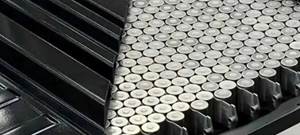Editorial - 4/1/2005
I'm writing this column from the Conference on Corrosion, Construction & Infrastructure in Las Vegas (March 8-11). I've attended this biennial event since the late '80s, when it was sponsored by the Western division of the Society of the Plastics Industry (SPI). Now under the American Composites Manufacturers
I'm writing this column from the Conference on Corrosion, Construction & Infrastructure in Las Vegas (March 8-11). I've attended this biennial event since the late '80s, when it was sponsored by the Western division of the Society of the Plastics Industry (SPI). Now under the American Composites Manufacturers Assn. (ACMA) umbrella, the event has assembled, throughout the years, knowledgeable polymer chemists and engineers from academia, material suppliers and parts manufacturers who, as a group, take on some of industry's most aggressive challenges. The winner of this year's Frank A. Cassis Award for Innovation in Corrosion Resistant Composites was inventor Norman Fawley of NCF Industries (San Luis Obispo, Calif.), who has spent a lifetime designing and creating cutting-edge industrial products using reinforced materials. A paper co-written by NCF and leading North American energy company TransCanada discussed several projects for reinforced pipe and high pressure gas transport modules (GMTs) developed by NCF, which have the potential to use literally millions of pounds of composite materials. The Conference showcased several other notable applications that represent manufacturing opportunities in corrosion-resistant structures that, together with the TransCanada project, may seriously challenge the industry's ability to meet demand.
Annual growth in several of the sectors using corrosion-resistant products already is expected to exceed the 5 percent predicted for the composites industry as a whole by Ray MacNeil, business analyst from PPG Industries (Pittsburgh, Pa.). Some manufacturers, including Martin Marietta's Grant Godwin (Raleigh, N.C.), the conference keynote speaker, feel we are nearing a pivot point where the benefits of composites finally will be realized and we may see explosive growth in the next few years! His presentation, cleverly entitled, "Reversing 200 years of Metals and Concrete Experimentation," asks why the world continues to tolerate the use in civil and industrial applications of materials so singularly ill-suited to the job at hand, when there are much better solutions readily available in composite materials. Godwin then showed a few pictures of corroded, dilapidated wooden, metal and concrete structures — and we all had a good laugh. His larger point, backed up with statistics, was that composite materials have actually come a long way since they were introduced to industrial markets in the '70s, and better times are yet to come.
While cost is always critical, manufacturers in these sectors don't face the degree of price resistance that we see in automotive and consumer products. In many applications, such as huge tanks, cooling towers, wind blades and specially designed, one-of-a-kind structures, composites may not be more expensive than the material previously used and they may provide multiple solutions to present problems as well.
Speaking of structures, our "Composites and Concrete" update in this issue of Composites Technology sheds light on lightweight concrete building panels reinforced with fiberglass mesh or chopped fiber (p. 36). These products are becoming well established in the precast concrete panel segment. We also bring you up to date on successful commercializations of nanofillers in composite resins (p. 42). While still relatively new technologies, they are already enabling composite product designers to circumvent previously unavoidable trade-offs in processing and performance properties.
We also got the exclusive story on the design and manufacture of the compression-molded SMC pickup box on Honda's new pickup truck, the Ridgeline ("Engineering Insights," p. 52). A standard feature (not an optional upgrade), the composite box sports several unusual features, not the least of which is a first-ever integral locking trunk. And since we'll soon cross the Atlantic to the JEC Show, we thought it might be a good time to take a look at "Distributors in the Composites Industry" (p. 28) and the roles they play as key international links in the global supply chain.
See you in Paris!
Related Content
Trends fueling the composites recycling movement
Various recycling methods are being considered for composites, from novel dismantling and processing, to building capacity and demonstrating secondary use applications.
Read MoreComposites end markets: Batteries and fuel cells (2024)
As the number of battery and fuel cell electric vehicles (EVs) grows, so do the opportunities for composites in battery enclosures and components for fuel cells.
Read MoreHonda begins production of 2025 CR-V e:FCEV with Type 4 hydrogen tanks in U.S.
Model includes new technologies produced at Performance Manufacturing Center (PMC) in Marysville, Ohio, which is part of Honda hydrogen business strategy that includes Class 8 trucks.
Read MoreComposite bipolar plates provide 81% improvement to hydrogen fuel cell power density
Ultra-thin CFRTP plates developed by Hycco achieve a 7.5 kilowatt/kilogram power density, high durability for fuel cells in long-flight drone and heavy-mobility applications.
Read MoreRead Next
Ceramic matrix composites: Faster, cheaper, higher temperature
New players proliferate, increasing CMC materials and manufacturing capacity, novel processes and automation to meet demand for higher part volumes and performance.
Read MoreUltrasonic welding for in-space manufacturing of CFRTP
Agile Ultrasonics and NASA trial robotic-compatible carbon fiber-reinforced thermoplastic ultrasonic welding technology for space structures.
Read MoreCutting 100 pounds, certification time for the X-59 nose cone
Swift Engineering used HyperX software to remove 100 pounds from 38-foot graphite/epoxy cored nose cone for X-59 supersonic aircraft.
Read More








